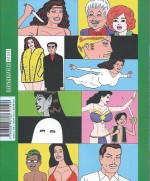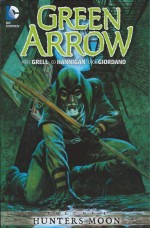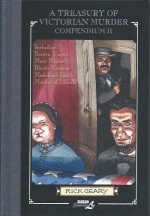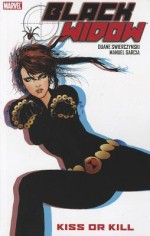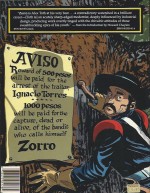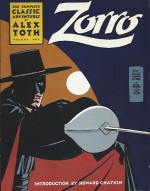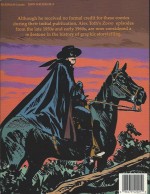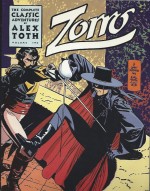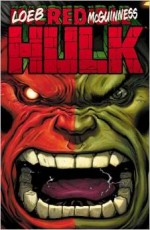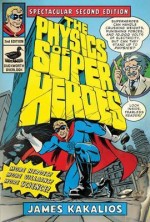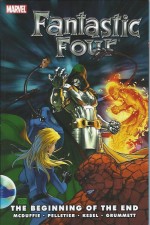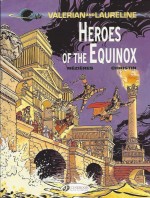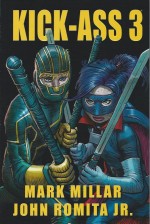
By Mark Millar, John Romita Jr., Tom Palmer & various (Titan Books)
ISBN: 978-1-78329-087-1
Once upon a time, perennial High School no-hoper Dave Lizewski – a pitifully ordinary and unhappy teenager who loved comicbooks – realised that he had no chance of being part of the school “in-crowdâ€. He just hung out with the other geeks, nerds and social lepers; talking TV, movies, funnybooks and wishing he could have a perfect life and trophy girlfriend.
Then one day he had his big inspiration – he was going to be a masked superhero. All he needed was a costume and a gimmick. Oh, and a codename too…
Clad in a wetsuit bought online and filled with hope, Dave started patrolling the streets and promptly got beaten into a coma by three kids tagging a wall…
After months in hospital and with three metal plates in his skull, Dave eventually returned to school, but the compulsion had only grown stronger. Soon he was prowling the city again. This time a chance encounter was recorded on witnesses’ camera-phones and uploaded to YouTube…
An overnight internet sensation and supremely now overconfident, Dave – or Kick-Ass – inspired a wave of copycats, attracted the extremely unwanted attention of Organised Crime and met the closest thing to real superheroes the world had ever seen…
Dave’s life went into deadly overdrive when he met diminutive Mindy McCready – AKA Hit-Girl – and her burly, brutish, utterly insane senior partner Big Daddy: cool, efficient ninjas of justice and everything he’d aspired to be but could never approach in a million years…
These armoured, gun-toting urban vigilantes were utter ciphers, stalking and destroying the operations of brutal Mafia boss Johnny Genovese with remorseless efficiency and in complete attention-shunning anonymity. Before long Dave was drawn into their war and met fellow adventurer Red Mist, who turned out to be Genovese’s abused, psychotic son Chris: a bastard maniac in his own right.
Things got really out of hand and lots of people died. Mostly scumbags, but some good people and a few innocent civilians too…
The mesmerising saga comes to a cataclysmic climax close as Kick-Ass 3 collects the final 8-part miniseries (originally published through Marvel’s Icon imprint) from Mark Millar, John Romita Jr, Tom Palmer and Dean White in a beguiling full-colour mass market paperback.
As seen previously, Red Mist had evolved into a truly psychotic and blood-drenched super-villain to counter the fannish tidal wave of costumed champions. In the aftermath of a bloody slaughter, superheroes were outlawed in New York, Dave and faithful masked pals Todd and Marty went undercover and the totally OTT Hit-Girl was arrested and sent to prison…
The saga resumes now with the lads reviewing a letter from the deadly tyke and planning to bust her out with the aid of a few costumed associates. However, life is not as clear cut as comicbooks and the scheme ignominiously fails.
Life goes on and the boys graduate High School, seeping into dead-end jobs whilst spending nights patrolling and training for their next attempt. Soon, though, tensions begin to rise as skeevy newcomer hero The Juicer takes over their once-communal lair – formerly Mindy’s old tricked-out HQ. The gloating sod even moves in his girlfriend…
Disgusted, undeterred and resolved not to spoil things, Dave gets back to the streets. When a posse of gangbangers attempt to mug Kick-Ass the battle goes badly wrong before he is rescued by witness – and nurse – Valerie.
Elsewhere, greater events are afoot. Brutally maimed Chris Genovese is stuck in prison hospital awaiting trial when his uncle Rocco pays a visit. With the established hierarchy of organised crime decimated by Hit-Girl, the aged Don has returned from exile in Sicily. He had been shipped off years ago when his deviant tastes and merciless depredations proved to be too much even for the Mafia.
Now he’s back and making a move to unite all the criminals in America under his rule – and he plans to make Chris his heir…
Self-proclaimed super-villain Chris is a changed boy and wants no part of it, but Rocco has the police force on his payroll. Nobody ever says no to the Don…
The boy’s mother has had enough too, but when she sneaks into his room determined to execute her crazy child she catches someone else with the same idea…
Dave meanwhile has organised another attempt to spring Hit-Girl but even as he preps his motley crew, the lass in question is facing down her latest psychiatrist.
The malevolent tyke has spent the intervening months terrorising and pacifying the entire prison around her, whilst psychologically breaking a long string of mental health professionals assigned to her, but Dr. Alex White is made of sterner stuff. The ruthless, remorseless headshrinker is determined to crush not cure the waif-like homicidal maniac, whatever it takes…
Dave is a man distracted. Although he has planned a raid on the mob as they fête the recently released Chris, his attention is mostly on Valerie. Thus the consequent attack is a disaster and the badly-scared mystery men barely get away with their lives…
In the cold light of day the heroes have a bitter falling-out at Justice Forever HQ and Dave adds The Juicer to his growing list of arch enemies. It’s hard to care, though, as he and Val are dating now and he’s having sex regularly…
The only thing he hasn’t given up on is Hit-Girl. He will get her out, somehow, someday…
He doesn’t know it, but Dave is on a clock. Rocco is firmly in the driving seat now and obsessed with the tiny titan too. He wants her out of jail so that he can smash his treasured golden ice-pick right into her brain…
As Dr. White plays the latest card in his duplicitous bag of brain-bending tricks, at Vic Gigante‘s place the bent cop – and Rocco’s most influential agent on the NYPD – has an interesting idea. With three trusted pals he’s devised a way to make even more dirty money in a foolproof manner.
Soon a quartet of “Robin Hood†masked heroes are brutally raiding all of Rocco’s places of business; killing mooks and confiscating cash. The Skull & Bones boys claim it’s all being passed on to the poor and naturally everybody believes them…
Lost in a lustful daze, not even a timely intervention by Todd can shake Dave up enough to get back in costume and on track, but the increasingly bold raids of the Skull & Bones gang is driving Rocco crazy. Only when the deviant Don declares war on every masked hero in the city and despatches hit squads to gun them down wherever they are does Dave finally rouse himself from a besotted haze and get back on the streets…
The psychological campaign against Hit-Girl is also beginning to work. The formerly indomitable Mindy is retreating into memories of training with her dad and sharing those episodes with the exultant White.
Unfortunately the cocky doctor overplays his hand and seems to lose everything, but before he can reassess the situation Rocco Genovese has his family’s nemesis abducted from the penitentiary so that he can slaughter her in style.
Ferrying her to a big party at his estate, the Don thinks he’s won but is utterly unprepared for betrayal from within, the incomprehensible inability of Kick-Ass to give up and the sheer determination and total, sociopathic verve which inspires Hit-Girl in her holy mission to eradicate criminal scum…
Building to a cataclysmic, graphically hyper-violent, ferociously cathartic conclusion, the saga of simple soul Dave and the atrociously foul-mouthed Hit-Girl wraps up in unforgettable manner with plenty of shocking twists and surprises in a blockbusting clash which answers all the questions in a fashion fitting, furious and final…
The blackly comedic and ultra-violent comedy quartet of tales which comprise the Kick-Ass saga are the ultimate extension of the modern trend for “realistic†superhero stories whilst simultaneously forming a brilliantly engaging and cynically hilarious examination of boyhood dreams and power fantasies, delivered with dazzling aplomb, studied self-deprecation and spellbinding style.
Here Millar’s mesmeric script skilfully dances on the very edge of possibility and credibility, whilst the stunning art collaboration of John Romita Jr., Tom Palmer and colourist Dean White afford a vision of New York life that ranges from Paradise to Hell on Earth.
Bracketed by a pithy Introduction from screen writer Geoff Wadlow and Afterword Acknowledgements from writer and artist, this majestically wide-screen extravaganza is a sharp, superb and stunning tale not just for comics fans but a genuine treasure for all followers of frantic fun and fantasy in any medium.
© 2013 and 2014 Millarworld Limited and John S. Romita. All rights reserved.
Kick-Ass 3 is scheduled for publication on February 27th

